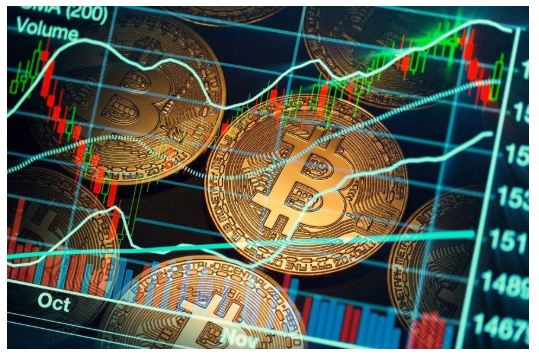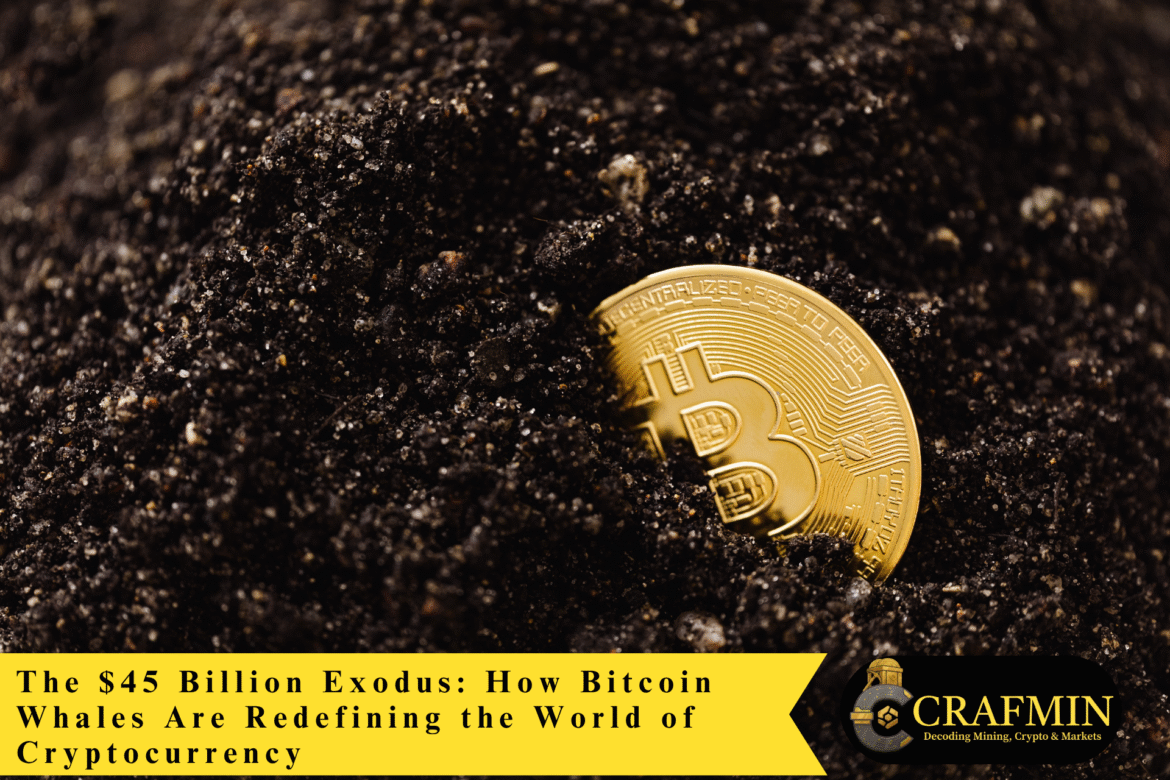A sell wave from large bitcoin holders has seen around 400,000 BTC, or around US$45 billion at current prices, migrate out of long-term wallets over the past few weeks. This is large enough to skew order books and lead to greater exchange flows. Analysts analyzing transactions say that this is not small profit-taking actionrather, it appears that a structural rotation is at play that market participants have to factor in. (bloomberg)

Whales move $45B back into the market (Image Source: The Market Periodical)
Why This Figure Is Important
When whale transactions or large wallet transactions of hundreds of thousands of units of coins take place, it alters the market microstructure. There is a surge in sell-side positions at all stock exchanges; market liquidity is affected at crucial price thresholds, while options traders also re-price positions. Consequently, greater price actions are observable in terms of lower trading activities than common expectations dictate. Findings that long-term holders have been unloading a total of 400,000 units of BTC in recent weeks explain why spot market liquidity and implied volatility have been increasing.
What It Tells Us: On-Chain Signals
On-chain tracking tools and exchange flow analysis tools picked up an increasing trend of fund transfers to centralized exchanges, as well as an increased pattern of wallet activity. Large inflows of funds to large centralized exchanges have been picked up by on-chain tools as a common precursor to selling pressure. On the other hand, it was noted that the realized market cap was concentrating in new “whales,” as well as a rotation of funds that had been inactive for several years.
Storytelling: A Quick Human Perspective
Consider a small coastal town that has just one major fish buyer, and it decides not to purchase fish for an entire month. This causes a stir as people sell fish at the dock, while market trends indicate fluctuations in fish prices. Fishermen, in turn, start looking for alternative buyers. Now substitute “fish” with “Bitcoin” and “Buyer” with a few wallets that contained coins for a whole decadeand you’re given a feel of the emotional setting.
Who Are The Whales?
“Whales” include early adopters who have amassed funds at near-zero costs, mining pools, family offices, or investment firms that represent clients’ aggregate positions. It is not possible to identify specific individuals behind particular addresses; however, behavioral characteristics such as extended dormancy followed by coordinated transactions can indicate whether a transaction is a result of profit-taking, estate rearrangement, or a transfer to a custodial wallet. In recent publications, decades of dormancy have awakened, while new major holders have swelled exchange reserves, making it a complex story. (cfx)
Immediate Market Reaction
Price effect is immediate.
Spot markets experience an expansion in bid/offer spreads, while funding rates in futures markets reverse, and options markets experience an expansion in implied volatility. In the short term, Bitcoin’s price temporarily dropped as traders absorbed the increased supply offered in the market, while options traders have also started positioning for a possible weakness.
Market coverage of major industry outlets is a reflection of the impact that pushes BTC and ETH as a result of an outflow of funds within the altcoin markets.
Observe the low time frame activity from ETF-dominated coins vs altcoins. ALTS want to (and are) pumping harder out of this dip. Spot selling, mainly from ETFs via Coinbase is keeping BTC and ETH weighed down. pic.twitter.com/WavOIvyvdG
— Spyro (@spyrotrading) November 4, 2025
Two Possible Motives (And Their Implications)
- Profit Realization
Long-term investors realize profits after a strong market rally. This will lead to a one-time influx of supply into exchanges, followed by a period of market consolidation as demand replenishes supply. Profits are reinvested in new businesses or flow out to fiat currencies. Weeks pass as a supply shock is absorbed by markets. - Structural Rotation
Whales swap from spot BTC to other assets (stablecoins, altcoins, ETH, staking derivatives) or to a custody product. This means that a deeper-seated market structure change is underway: a decrease in long-held BTC and an increased amount of volatile funds that turn over quickly. There is evidence that this is at least partly in effect.
Why Behaviour In Institutions Is More Important In the Current Context
Institutional participation means quantity and planning. Institutional outflows will swing market liquidity in a matter of minutes, triggering algorithmic trades as a result. When asset managers or family offices choose to sell out of BTC, they act in a manner that impacts exchange order books, prime books, or arbitrage trades related to ETFs effectively in unison. Recent events have emphasized that institutions and seasoned participants continue to drive market reaction through changes in realized cap and wallet distribution.

Market shifts follow institutional moves (Image Source: PM News Nigeria)
Exchanges, Custody, And Where Of The Exodus
A large proportion of those relocating their coins ended up in centralized exchanges, a hallmark of preparation for sale. Other funds were sent to non-custodial wallets or DeFi channels, which could represent a strategy of hoarding for staking/strategy purposes or may usher in decentralized trades. Industry observers derive meanings based on CEX versus those sent to cold wallets in terms of intent, which is seen as actions before liquidity events in CEX versus accumulation/holding in cold wallets. Apparently, according to recent observations, all are happening simultaneously.
Industry Trends In Relation To Market Participants
- Retail traders need to be aware of higher volatility that could easily lead to over-leveraging. Spikes in volatility present both danger zones and trading opportunities.
- Trader/Prop desks: Strict risk controls required; liquidity vendors will increase spreads but harvest premiums.
- Long-term investors – Do they ask if it is a new normal or a cycle of rebalancing? Long-term investors tend to purchase dips caused by such events.
- Regulators & Custodians must monitor outflows carefully as large flows to exchanges may trigger AML/KYC alerts & put pressure on custodial capacities.
What We Learn From History’s Analogs
Historical whale trades in 2013, 2017, or in patterns that have evolved ever since have illustrated that while large sell-outs have been absorbed by the market, it was a painful experience nonetheless. Also, ever since a new cycle has evolved with a growing number of buyers in institutions, ETFs, or individual investors through mobile platforms. On receiving new supply, market responses are instantaneous, while longer-term stories of adaptation, or changes in monetary or macroeconomic conditions, have defined trends of either revival or decline.
Back in 2018 HODL was a real thing.
People believed in holding coins. Winning in 2014-2017 cycle was easy you just gotta be stupid and be holding any coin.
2018-2021 cycle was still easy but harder comparative to 2014-2017 cycle because you needed to pick good infra tokens and… https://t.co/IGaq0Cnkmv pic.twitter.com/HI2T66oY90
— Zorro (privacy szn) (@LmaoZorro) November 4, 2025
“Market Structure Issues Posed By Israel’s Exodus Of Researchers”
- Are centralized exchanges becoming major sinks for whale liquidations, or is it that whales are increasingly choosing to route through over-the-counter desks to remain non-disruptive? It is likely a bit of everything.
- Does it lead to a rotation of funds into new crypto assets or an outflow of funds to fiat? Stablecoin transactions and OTC transactions will bear watching.
Signals To Monitor Next (Practical Checklist)
- Exchange balances a steady stream of funds, suggesting that more will continue to come in.
- Realized Cap Concentration: Who controls supply after the rotation?
- Large over-the-counter prints and block trades are a sign of strategic institutional buying, rather than panic-selling by individual investors.
- On-chain swap to ETH or stablecoins implies rotation rather than outflows to fiat.
- Derivatives markets, options skew, and futures funding demonstrate pricing of tail risk.
Scenario Analysis: Three Possible Paths That The Market May Take
Imagine that the market is a busy port. Whale moves tens of billions of dollars, so it’s a fleet moving docks; it’s a matter of a few tidal changes before it’s a flood, or a new balance is discovered. Below are three possible scenarios, sources of those scenarios, and how market participants should make sense of early indicators.
1) Bearish Distribution (Likely, Short-to-Medium)
- What happens in crypto markets: Whales continue pouring coins into exchanges and over-the-counter desks. Supply exceeds demand, and the market price declines further. Volatility increases as funding rates turn negative. Derivatives traders start increasing interbank spreads.
- Forces driving it: Profit-taking from long-term holders, macro fear of risk in headline announcements, or institutional liquidity needs. Significant revival in dormant wallets and increased flows to exchanges.
- Signals that will be monitored include: a balance of exchange increasing, a growing realized cap moving to new investors, and an increase in block transactions to marketplaces. If funding and options skew are high for several days, such a scenario is likely to be seen.
- What it means for participants: Short-term traders will find market momentum in directional trades, but liquidity will be limited at market extremes. Long-term investors will encounter greater drawdowns in value, but also need to gauge if market declines meet buying criteria.
2) Rotation Within Crypto (Neutral-to-Bullish Long Term)
- What happens: Whales sell spot BTC as a strategy to round out their crypto exposures, ETH, regulated spot/derivative products, staking vehicles, or stablecoins. Market structure changes less “dormant” supply, more active flows.
- Catalysts: Redirection of funds towards ETH staking, DeFi investment, or a structured crypto treasury. On-chain data of swappings to ETH, as well as DeFi channels, lessens the risks of pure fiat outflows and suggests churning within and not a wash sale.
- Signals include: an increase in chain swap transactions to ETH, a combination of stablecoin creation volume with BTC outflows, and a decrease in overall exchange outflows.
- What it means for participants: There is a feeling of market chop, though overall adoption and on-chain activity continue to be robust. There is arbitrage across assets, while longer-term investors supporting multiple assets in crypto may feel that this is a positive rebalancing act.
3) Panic Cascade (Low Probability, High
- What happens: A chain of forced liquidations (derivatives, margin calls) magnifies this buying, causing sharp price declines that in turn trigger stop-loss sweeps and market moments of instability.
- Catalysts: A surprise macro event or selling in thin windows of liquidity. Although it appears that sales will come from long-term investors choosing to take profits, systemically significant events would come to pass if levered positions exceed liquidity. Recent reporting suggests sales will come from long-term investors and not necessarily leverage-induced bouts of capitulation, reducing near-term probabilities, but it is possible in thin windows.
- Warning signs include: explosive increases in liquidations, appearances of jual/ISO/empt/empt ISO when exchange spreads blow out, and large executions that are well away from NBBO in spot books.
- What it means for participants: Risk controls are highly important, as liquidation events pose a possibility of extreme short-run losses, even in unlevered portfolios.
Macro And Regulatory Implications: What Policymakers And Big Finance Watch Next
- Macro sensitivity increases: Large BTC transactions are seen in conjunction with supply shocks that converge with macro announcements such as interest rates and inflation or geopolitical issues. Large transactions are now considered a legitimate market-moving data point by traditional macro teams.
- There is a growing regulatory focus: Large and concentrated transactions sent to an exchange will be subject to AML/KYC checks and could result in a regulatory inquiry if transactions cross borders quickly. This is because regulators are monitoring transactions that rapidly build liquidity in smaller exchanges.
- Custody & prime-broker implications: The Custody & liquidity process remains in vogue in institutions again. This is because prime brokers need to film for extended trades in light of increased whale activities in over-the-counter desks in an attempt to impact markets the least.
- ETF & institutional investment channels adjust: When institutions cut back their spot BTC investment allocations, ETF arbitrage investment flows, and AP actions might alter futures vs. spot market relations and thus arbitrage profitability.
$NQ $ES $BTC | Risk Assets Decoupling
When liquidity flows freely, both BTC & stocks pump (Risk On). But when the Fed injects liquidity via repo ops like it did over the weekend the reaction can diverge: https://t.co/YXN3Yuomt7Bitcoin is a pure liquidity barometer as… pic.twitter.com/Zd0tbYWtfJ
— Interbank (@_interbank) November 4, 2025
Technical Playbook: Trades and Risk Profiles Based On Investors’ Type
The following are non-prescriptive suggestions based upon time horizon and risk tolerance. Do not invest funds that you cannot easily part with. Use only as a template.
For Those in the Cons/Analysis Group
- Do not do anything if your thesis is long-term. Use drawdowns for dollar-cost averaging (DCA) if it is within your plan.
- Do not use leverage, and in fact, prefer custodial solutions that have robust insurance and multisig.
For Active Traders (Intra-day To Swing)
- Strengthen risk controls by reducing positions and using limit orders instead of market orders in thin windows of liquidity.
- Liquidity in trades – focus on smaller time periods with well-defined levels, as well as monitoring delta changes in exchange balances.
- Use options as hedges: Buy put spreads to limit loss while allowing profit. Note that IV rises in whale trades, increasing the costs of premiums.
For Institutional Allocators & Funds
- Executions should be divided across over-the-counter, block desks, and smart order routers to mitigate market impact.
- Dynamic rules that start when liquidity thresholds are present (min 10 BTC in market order book) could be considered.
- Keep fiat buffers or stablecoin reserves to mitigate possible short-term outflows without fire-selling.
For Yield-Seekers & DeFi Users
- Note that a rotation of whales toward staking/DeFi activities will necessitate monitoring of counter-risk in those areas, as APYs will go up with an increasing supply of assets.
- Use an audited protocol, a staggered lock-up schedule, and multiple layers of custody.
Also Read: Crypto Regulation Challenges US: Trump-Backed Crypto Market Structure Bill 2025 Faces Delay
Desired Indicators & Watchlist (Tactical)
- Exchange Balances: Inflows of large CEXs boost sell-side chances.
- Actualised Cap and Cohort Flows: Which cohorts sell? Long-term reactivations are more concerning than short-term ones.
- Options Skew and Funding Rates Indicate market volatility and tail-risk-adjusted market costs.
- Stablecoin Creation & ETH Swap Volume Rotation indicators, not fiat outflows.
- OTC Block Trades Printing large blocks of trades off of exchange represents calculated institutional sales rather than panic retail sales.
Closing: What To Watch This Week
- Exchange balances & large wallet transactions (daily).
- Funding rates and options skew across major platforms (intraday).
- Stablecoin creation & ETH swap transaction metrics (signal rotation vs exit).
“The -$45 billion outflows event is a watershed moment in the near-term.” This highlights market structure, where such a large supply concentration intersects with a lack of market liquidity, and challenges perceptions of how market participants in a maturing market a means of describing a growing but volatile market, execute large-money flows of either a bullish or bearish bent.
Keep your “horizon in sight, observe exchange flows, and see volatility as a characteristic to be managed, not a statement about crypto’s future.”
Frequently Asked Questions
- Q: Are those sales of 45 billion Bitcoins by whales, or is it market cap?
A: This is a reference to the value of the dollar amount of coins moved or realized from long-term holders of around 400,000 BTC and is a reflection of large transactions that have occurred, which, at today’s value, represent around 45 billion dollars. This was reported by Bloomberg and an analysis of transactions. - Q: Are the whales dumping or reallocating?
A: Both, according to evidence. Coins went to an exchange (meaning sale) and others to ETH or DeFi programs (meaning re-allocation). This is a balance that shows either a bearish supply shock or just a rotation in crypto. - Q: Must retail investors panic and sell?
A: No, although they should not use high leverage. Whales induce market instability. Smart risk management is more important than market fluctuations in a given time period. - Q: Will it spark a bear market?
A: No, definitely not. Large sales could lead to large immediate dips in value, but eventually value will be determined by demand trends related to new users entering to consume product offerings. This has happened in previous trends that bounced back after a while. - Q: How do I monitor whale activities?
A: Make use of chain analysis tools as well as balance dashboards, whale alerts, and derivative market data. - Q: How accurate is the 400,000 BTC statistic?
A: Analysts aggregate data of on-chain reactivations and exchange transactions to calculate an estimate, though Bloomberg sources 10x Research’s Markus Thielen as saying that ~400,000 BTC was involved. On-chain attribution of sales is probabilistic, although large and trend-oriented. - Q: Does a transfer of coins to an exchange indicate that they have been sold?
A: Not in all cases. This will often be a prelude to a sale, but it could also represent a transfer of funds or a temporarily resting balance. This will become clearer when analyzing the relationship between exchange fund flows to executed sales. - Q: Are whales always harmful to price stability?
A: No, because whales provide liquidity during accrual phases and have a market-stabilizing effect. Where a lot of large investors coordinate sales in order books of low liquidity, problems emerge. - Q: Does that mean that it is either maturing or fragile?
A: Both. Industry maturation is a result of developed institutions and whale networks that engender deeper funds and evolved execution channels. Vulnerability is subjective when strategic investors retain substantial supply, and a limited number of execution points exist.

